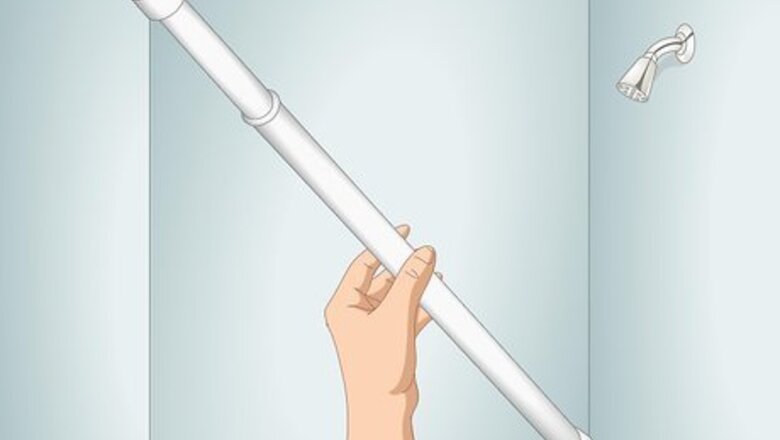
views
Installing a Tension Shower Curtain Rod
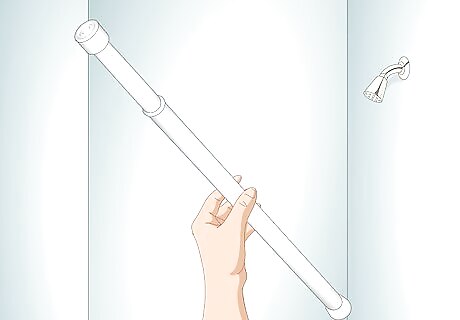
Get a standard tension rod if you want to make things easy. Tension shower rods are inexpensive, easy to find, and require no tools or hardware. They rely on the tension of your shower’s walls to remain stable and can be easily adjusted or moved. When looking at a tension rod, make sure that the maximum length exceeds the distance between your bathroom’s walls. Purchase a tension shower rod online or at your local home supply store.Tip: The standard length of a tub is 60 inches (150 cm), and most tension rods extend from 48–75 inches (120–190 cm). You shouldn’t have a problem installing a tension rod unless your shower is abnormally large or small. If you’re renting, get a standard tension rod. Mountable shower rods often require drilling into the tile in the bathroom. Tension shower rods come preassembled, which makes installation easy. It shouldn’t take more than 5 minutes to install a tension shower rod. Tension rods also don't require any drilling.
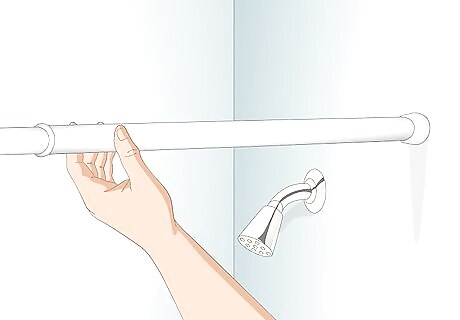
Place one end of the tension rod against one end of the wall. It doesn’t matter which end of the rod you start with. Place one end against the wall in your bathroom where you want to install it. Hold the cushion against the tile or drywall with your nondominant hand. Grab a stable step ladder if you can’t naturally reach the height where you’d like to install the rod. You can slide the rings for your shower curtain through the rod before installing it if you want to make things easier. You can measure the height where you want to install the rod if you’d like, but it’s unnecessary. Tension rods are so easy to move that it’s not worth wasting the time. If you do measure, place your rod 72–75 in (180–190 cm) above the ground to keep the curtain off of the floor.
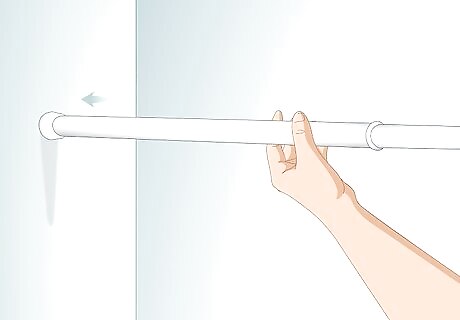
Pull the rod out until it reaches the end of the wall on the opposite side. You’ll notice a dividing line in the middle of the rod where one end of the rod slides into the other half. While holding one end against the wall, extend the other half of the rod by pulling it out and sliding it. Extend it until it reaches the wall on the opposite side. Some tension rods can’t be pulled out like this. These rods need to be turned clockwise to extend.
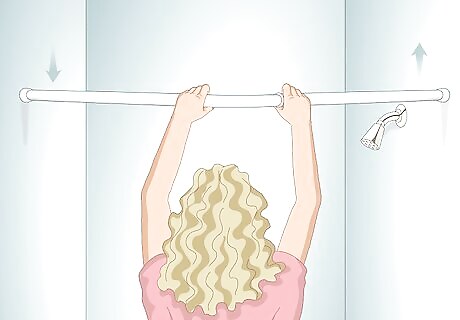
Adjust the shower rod until it’s even and level. With your rod extended, move it in place until the rod is even and level. You can tell when it’s level by looking at the pads on either end to see if they’re both flush with the wall. Don’t worry if it isn’t perfect—you can always adjust it later after you’re done. If you’re installing the rod on a tile wall, you can count the number of tiles from the ground to the rod on each side to see if the rod is even.
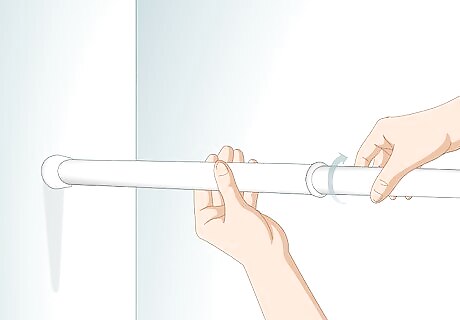
Hold the larger portion while turning the smaller end of the rod. With your rod in place, brace the larger portion of the rod with your nondominant hand. Then, twist the smaller length of the rod clockwise to tighten it. Continue tightening the rod until it is firmly in place. If you notice the tension getting lower as you turn the rod, try rotating it the other way. If you ever need to adjust the location or length of your shower rod, turn the smaller portion 3-5 times to loosen it a little and simply move it.
Hanging a Mounting Shower Curtain Rod
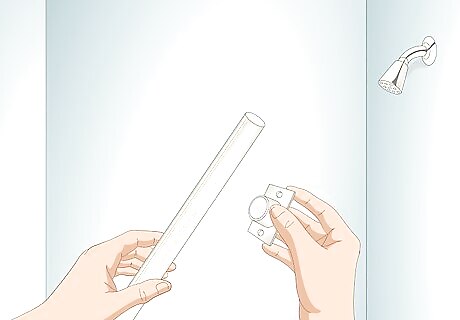
Selecting a mountable shower rod if you want a cleaner look. Mountable shower rods look much nicer than tension rods, but they are harder to install and may require drilling. Get a mounting shower rod if you own your home and don’t mind doing some extra work to get a cleaner look. Mounting rods come in 2 distinct styles. One requires drilling a bracket into the wall. The other uses magnets or adhesive to stick right on to your wall. If the brackets have a frame, install the frame first. If one of the brackets has an opening, install it so that the open end faces up. There are curved mounting rods that you can get if you have a curved tub or want some extra elbow room. Mounting shower curtains will come with the screws and brackets needed to install them.

Measure and mark the height of your brackets. Select a location on your wall to install your shower rod. Most people choose to install it directly above the edge of your tub, 72–75 in (180–190 cm) above the floor. Use a measuring tape and a pencil or dry erase marker to put a dot where you’re going to install the bracket.Tip: If your brackets are really big, hold the bracket over the mark that you make and trace the bottom with your pencil or marker. This will give you another point of reference when you drill the brackets in. If you have the choice between drilling into tile and drying into drywall, install the brackets in the drywall. Tile can crack quite easily if you aren’t careful when you’re drilling.
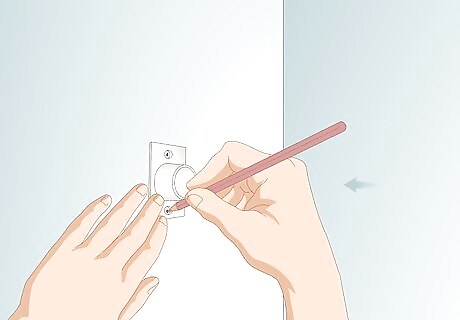
Repeat this process on the opposite side and check to see they’re level. Use your measuring tape and a marker or pencil to calculate the height of the bracket on the opposite side. Then, use your measuring tape to check to see if the marks are equidistant from the edge of the wall. If they are, run a level from one bracket to the other and check the bubble in the middle to see if the brackets are even. Make adjustments to your guiding dots as needed to ensure that the brackets will be even and level. Sometimes, the shower rod will come with one of the brackets pre-installed. If this is the case insert the rod into the bracket to test your location. If one of your brackets has an opening, it must face up so that your shower rod can rest on the bottom of it.
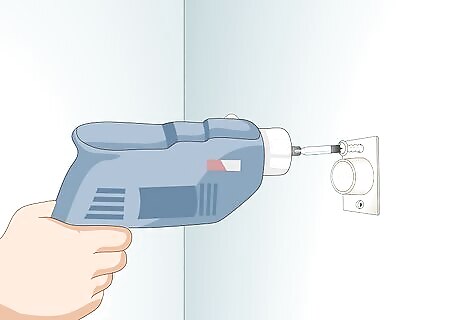
Install your brackets over the dots using a drill or the adhesive. If your bracket is adhesive, clean the wall before peeling the back off and pressing it into your tile or wall. If you’re drilling, put a strip of masking tape over the surface to give the drill bit some grip. Hold the bracket up and insert the screw into the opening. Use the lowest power setting available to drill the screw into the tile or drywall. Repeat this process on the other bracket and with every other screw. You can skip the masking tape if you aren’t drilling into drywall. Put a carbide-tipped masonry bit on your screw if you need to drill into tile. You do not need to install the mounting brackets into a stud. Curtain rods aren’t heavy enough to require extra support. If one of your brackets has an opening at the top, make sure that it’s facing up. These rods are installed by inserting one end of the rod while lowering the other end into the open bracket. If your screws are bigger than ⁄8 in (0.95 cm), you may need to drill a pilot hole for your screws with a ceramic-graded drill bit.

Twist the brackets into the frame if you have locking brackets. Some brackets come in 2 separate parts: the frame that you drill into the wall and the fixture that goes on top of it. Once you’ve drilled the frame into the wall, slide each bracket through the shower rod. Then, hold your rod up and slide your first bracket into the frame. Twist the bracket around the frame clockwise until it locks into place. Repeat this process on the opposite side to finish installing your rod. These types of rods can be kind of awkward to install since you need to balance the rod while you’re turning the brackets into place.

Lower your rod into place if you have open brackets. If your brackets have an opening at one end, slide your rod into the closed bracket. Then move the other end of the rod above the bracket on the opposite side. Lower it into place to finish installing your shower rod.




















Comments
0 comment